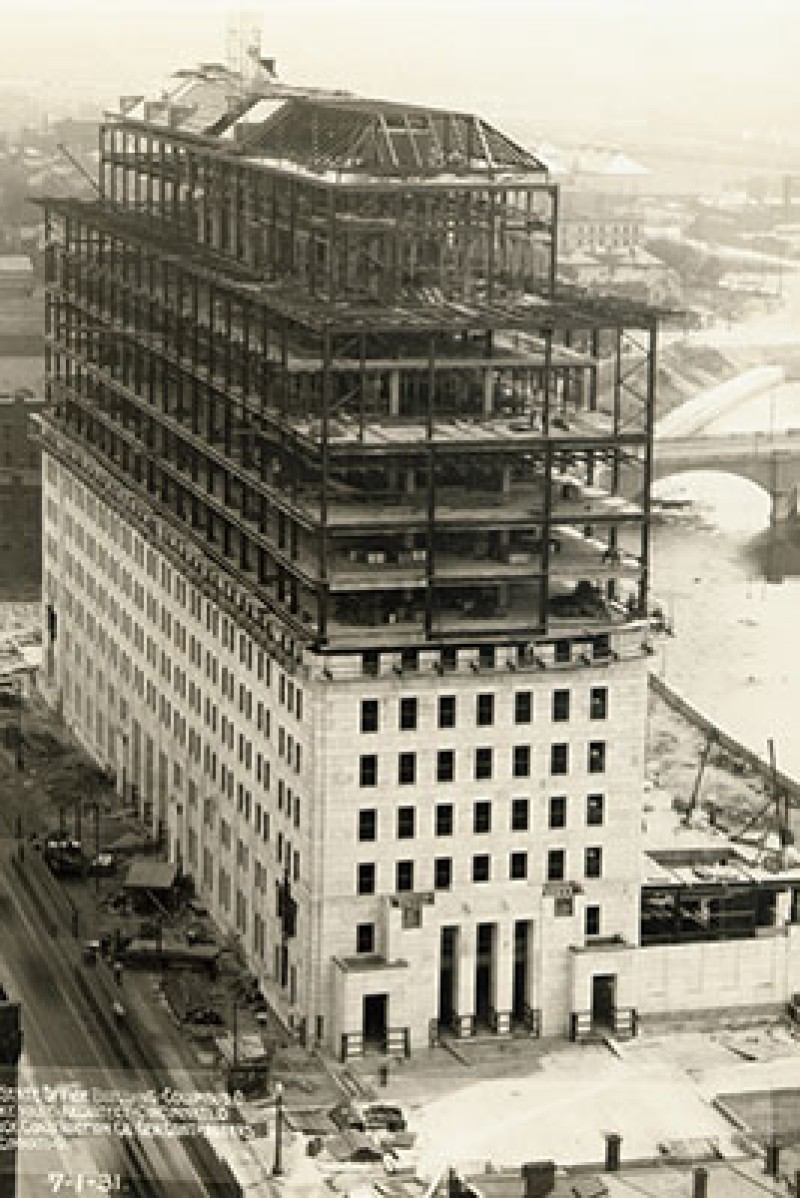History of the Moyer Judicial Center
At the beginning of the 20th century, the Ohio population and economy were booming. State government also grew, adding more employees than could work in the Statehouse.
The idea to construct a new office building first surfaced in 1913, igniting a debate spanning 16 years. As government continued to grow, the discussion shifted from whether to build to where and how to finance. The tipping point came in 1929 when the city of Columbus agreed to donate 2.1 acres on Front Street.
Harry Hake, a prominent Cincinnati architect, was hired to design the building. His 292 pages of specifications called for 415,000 square feet; considered sufficient space to meet the needs for the next decade. The $5 million cost, including $1.5 million to purchase additional property, was financed by a property tax.
The building, which came to be known as the Ohio Departments Building, was planned as the curtain was coming down on the Roaring Twenties. The stock market collapsed in October 1929, just three months after Hake was hired. Construction began in 1930 but was frequently delayed by labor disputes. With the project almost complete, a natural gas explosion at the site killed 11 workers and injured 50 others on April 14, 1932. Windows were blown out of their frames, staircases up to the 5th Floor were destroyed and the monumental bronze doors on the west side were blown off their hinges.
Workers immediately started repairing the damage, at a cost of $750,000 and the building was ready in March 1933. Initial tenants included the Industrial Commission, the State Library and the departments of Aeronautics, Agriculture, Commerce, Education, Health, Highways, Public Welfare, Public Works, Industrial Relations and Taxation.
In addition to housing various departments of state government over the years, the Ohio Departments Building was home to the Ohio House of Representatives during the Statehouse renovation in the 1990s.
In 1998, the General Assembly agreed to fund renovations to the original Ohio Departments Building. At that time, the structure that held the stone to the building had become so deteriorated that the stone was starting to fall off the building in chunks. The Columbus architectural firm Feinknopf Macioce Schappa was selected to carry out the exterior renovation, which included replacement of all 998 windows, replacement of the exterior façade stone and support structure from the third to the tenth floors.
In 2001, while Feinknopf Macioce Schappa continued with the reconstruction of the plazas, fountains, entries and handicap ramps at the entries and plazas, the Columbus architectural firm Schooley Caldwell was tasked with restoring the building’s interior to its past splendor and updating it for modern office needs. Interior construction involved a complete restoration of the building's Grand Concourse and the original hearing rooms — the largest serving as the main Courtroom. What was the State Library has been converted to the Supreme Court Law Library. In addition, the building includes an education center, flexible meeting rooms and adequate office space.
The renovation, completed by January 2004, meets both the immediate and foreseeable space needs for the Court and affiliated offices. For the first time, it has allowed Ohio's judiciary to consolidate in a single facility ensuring effective and efficient administration.
On Feb. 17, 2004, the Ohio Judicial Center opened its doors to the public for the first time, bringing forth a flood of visitors numbering in the thousands and a half dozen architectural awards and honors.
White House historian William Seale, a keynote speaker at the May 15, 2004, Ohio Judicial Center Dedication Luncheon, praised the project, noting that the building's architectural and artistic details make it one-of-a-kind. "No building like it will ever be built again."
On Dec. 2, 2011, the Ohio Judicial Center was re-dedicated as the Thomas J. Moyer Ohio Judicial Center in honor of the late Chief Justice.
250 | Estimated number of building occupants
11,295 | Number of visitors the first year
63 | Approximate percentage of those visitors who were students
15 | Different kinds of marble used in the building exterior
975 | Total number of windows
24,000 | Square yards of carpet
61 | Murals
18 | Ohio politicians depicted in bas-reliefs
4 | American Indian leaders depicted in bas-relief
15 | Ohio cities depicted in murals
78 | Percentage of construction materials that came from Ohio
300 | Estimated number of computers when the Supreme Court first moved
400 | Estimated number of phones when the Supreme Court first moved
547,000 | Length in feet (more than 100 miles) of fiber cable laid during the restoration
400,000 | Estimated number of books to be moved when the Supreme Court first moved
415,580 | Gross square feet of building
18 | Number of stories, including the ground floor, the basement and the attic
3,364 | Net square feet ( 92 feet, 2 inches long by 36 feet, 6 inches wide) in Courtroom
190 | Spectator capacity of Courtroom (normal configuration + additional seating)
315 | Total capacity of Courtroom (posted, per code)

Construction on this building began in 1930
